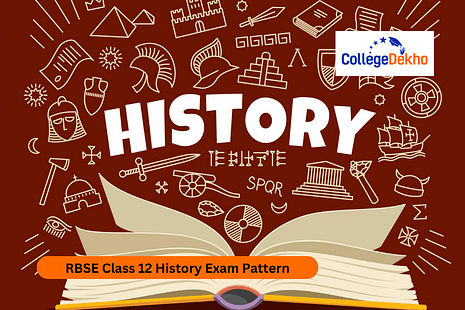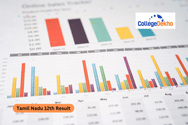

Never Miss an Exam Update
RBSE 12th History Exam Pattern 2025
: As per the history paper pattern, the subject is divided into 3 parts and 12 themes; each part has 4 themes. The total marks of part 1 is 22 marks, part 2 is 25 marks and part 3 is 33 marks. The marks allocated to the project work are 5 marks and the remaining 20 marks are allocated to the internal assessment. The paper includes MCQ, very short, short, and long-answer type questions and is divided into 4 sections. Section A includes questions from 1 to 10 each carrying weightage of 1 mark. In section B, students will find 2 mark questions from questions 11 to 18. Section C will include questions from 19 to 26, each of 4 marks. Further, section D has 4 questions of 6 marks each. The questions from 27 to 29 will have internal choices. Students can also download the
RBSE Class 12 History Model Paper 2025
to gain an idea of the exam pattern and types of questions asked in the exam, through which students can prepare for the exam.
Students are advised to go through the latest
RBSE 12th History Syllabus 2025
PDF released by the board to get a better knowledge of every topic mentioned in the syllabus. To get more details about the RBSE Class 12 History blueprint 2025, students can read the article carefully.
Also Check
RBSE 12th Time Table 2025
RBSE Class 12 History Exam Pattern 2025
Students can get a thorough understanding of the board marking scheme, question kinds, response options, and other factors by using the RBSE Class 12 History Exam Pattern. Students can check the details here.Themes in Indian History Part—I 22 Marks | |||
|---|---|---|---|
Theme No. | Theme Title | Learning outcome with specific competencies | Marks |
1 | Bricks, Beads and Bones The Harappa Civilisation | To look into, examine, and analyze the urban centres and social systems. Recognize and infer the multilateral features of Harappan civilization to comprehend the world's first civilization. Examine and evaluate sources from the past and present, as well as historians' and ASI's perspectives on Harappa. | 22 |
2 | Kings, Farmers and Towns Early States and Economies (c.600 BCE600 CE) |
To assess and examine significant changes in the political and economic history of the subcontinent.
| |
3 | Kingship, Caste and class Early Societies (c. 600 BCE600 CE) | To investigate and evaluate social history's problems.
Analyze social conventions to understand the societal perspectives found in the old Indian scriptures.
| |
4 | Thinkers, Beliefs and Buildings Cultural Developments (c. 600 BCE600 CE) | To deduce and contrast the principal theological advancements in ancient India. Explain the elaborate religious sculpture and deduce the meanings concealed within. | |
Themes in Indian History Part—II 25 Marks | |||
5 | Through the eyes of Travellers Perceptions of Society (c. tenth to seventeenth centuries) |
To apply what they had learned and to understand the essential components of the social histories that the travelers had told.
| 25 |
6 | Bhakti-Sufi Traditions Changes in Religious Beliefs and Devotional Texts (c. eighth to eighteenth centuries) | Recognize the changes in religion.
To understand the growth of religion during the Middle Ages, compile a summary of the teachings of various Bhakti and Sufi saints.
| |
7 | An Imperial Capital – Vijayanagar (c. fourteenth to sixteenth centuries) |
By classifying the distinctive architectural contributions of the Vijayanagar kingdom, students will be able to recognize the variety of blended civilizations present in Deccan India.
| |
8 | Peasants, zamindars and the States Agrarian Society and the Mughal Empire (c. sixteenth-seventeenth centuries) |
Learn about the facets of agricultural advancements to appreciate the interaction between the state and agriculture in the Mughal era.
| |
Themes in Indian History Part—III 33 Marks | |||
9 | Colonialism and The Countryside Exploring Official Archives |
Study the revenue schemes implemented by the British to understand the economic aspects of colonization in India.
| 33 |
10 | Rebels and Raj 1857 Revolt and its Representations | To examine the events of 1857.
Determine the domains and nature of the 1857 rebels by establishing a correlation between their planning and coordination.
Analyze visuals to comprehend the feelings that the British and nationalists are portraying. | |
11 | Mahatma Gandhi and the National Movement Civil Disobedience and Beyond | Recognize the nationalist movement according to its chronology. Establish a link between the essential elements of the nationalist movement and the traits of the concepts, people, and organizations Gandhi led. Discuss Gandhi's important contributions to gain an understanding of his widespread appeal for nationalism. Examine the various approaches to interpreting historical sources, including diaries, letters, autobiographies, and biographies. | |
12 | Framing of the Constitution The Beginning of a New Era | Highlight the role of the Constituent Assembly to understand functionaries in framing the constitution of India. Analyze how debates and discussions around important issues in the Constituent Assembly shaped our Constitution. | |
-- | Including Map work of the related Themes | -- | 05 |
-- | Theory Total | -- | 80 |
-- | Project Work | -- | 20 |
-- | Total | -- | 100 |
RBSE Class 12 History Previous Year Question Paper would be extremely beneficial to students to prepare for the final exam.
RBSE Class 12 History Blueprint 2025
From the table below, students can check the weightage of each chapter. This will help students figure out the important chapters. Accordingly, they can give more time and attention to the topics with higher marks.
| Unit | Sections | Marks Weightage |
|---|---|---|
| 1 | Ancient History of India | 10 |
| 2 | Golden pages of India’s history | 15 |
| 3 | External attacks and self-assertion | 10 |
| 4 | Mughal Invaders – Purpose and Resistance | 10 |
| 5 | Colonist attackers/Invaders | 10 |
| 6 | Modern Independence Movement | 15 |
| 7 | Rajasthan | 10 |
Total | 80 marks |
Students should go through each section on this page to know the exam pattern and prepare accordingly to score better marks in RBSE 12th Result 2025 . For more updates related to the RBSE Class 12 History exam pattern 2025, students can regularly visit the page.
Was this article helpful?






















